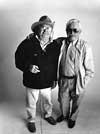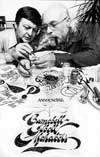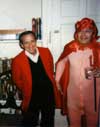Photos
2014
2015
2014
2013
2012
2011
2010
2009
2008
2007
2006
2005
2004
2003
2002
2001
2000
1990s
1980s
1970s
1960s
1950s
1947-49
1940s
1930s
1920s
Jerry Campbell pix update
An excerpt from Debi Martone's book, LET ME TELL YOU WHAT HAPPENED. |
||||||||||||||
|
|
|||||||||||||
 by Debi Martone
by Debi Martone
At CCS I was working towards a major in Graphic Communication with hopes of working at an art studio designing logos and creating hand-lettered signs, invitations and the likes. I was carrying a 4.0 GPA and had an offer to work at one of my professor's studios after I graduated.
Mr. Campbell had a lettering studio, where he created incredible logos, which, back then, were done completely by hand without the aid of a computer's perfection. He designed the logo for the Detroit Symphony Orchestra, among many other things. I found his work to be amazing.
Mr. Campbell was a short, older man. Although I never saw him with one, I pictured him to be a cigar smoker. He seemed to have the cock of the jaw and the slant of the teeth of someone who regularly clenched a cigar. Mr. Campbell's Introduction to Lettering course was in my first college semester. Going to a top-ten art school was intimidating and I worried if I would fit in with people who were more artsy than the nerd I felt I was. Seeing Mr. Campbell, who was like someone's favorite uncle, changed my perception. I felt out of place in my preppy clothes. I didn't hang out in the student lounge. I didn't branch out and meet many people. But going there wasn't about that for me and Mr. Campbell reassured me that I was where I belonged. Mr. Campbell showed off my work to the class and when he hung one of my lettering projects in a hall gallery I was even more thankful for his faith in me. Going there was about creativity on an individual level and I was going there to be myself. He helped me see that.
After surviving the first few boring weeks of what seemed more like scribbling, Mr. Campbell's lessons started to make sense. In classes to follow, he taught how to hand letter in a variety of fonts that the original scribbling played a big part of creating. The scribbling trained the class how to control the width of each letter, spacing, and the varied heights of individual letters, some of the significant aspects of hand lettering.
While we were working on projects in class, Mr. Campbell regularly wandered the room, looking over our shoulders, commenting on our pieces, making suggestions or criticisms. The hardest part of the class was trying to figure out what word or words to use for projects with specific font we were studying. When I created an "Oreo Cookie" lettering project, Mr. Campbell held it up and interrupted the class to exclaim, "That son of a bitch is popping right off the paper!" It was a huge compliment for him to single out a project and I was thrilled it was mine.
One of the other important lessons Mr. Campbell taught his lettering students was to hold our pencil or paint brush loosely. This enabled the lettering to be uniform and free flowing, resulting in something more pleasing to look at. Occasionally Mr. Campbell would sneak up from behind and pull the pencil or paint brush from our hands.
"See, you were holding on too tight," he would say as our utensil scribbled out of control, smearing paint or ink all over our project. However, if we were holding our pencil or paint brush loosely, as he taught, he could freely pull it out with no scribble at all.
Mr. Campbell only did this to me once. I was using a fat paint brush to paint thin, white letters on red paper that spelled the words, "Art of the Mummenschanz." It was my final draft after designing and lettering numerous overlays. Thankfully I wasn't holding the paint brush too tightly or my entire project would have been ruined. 
"Let this be a lesson in life for you, my dear," he said with a wink as he walked away. "If you hold on too tight things can get ruined. Then you have to start over from the beginning."
His lesson would stick in my head from that moment on, not only when I was holding a paintbrush or calligraphy pen but in many other aspects of my life.
--Debi Martone, LET ME TELL YOU WHAT HAPPENED











